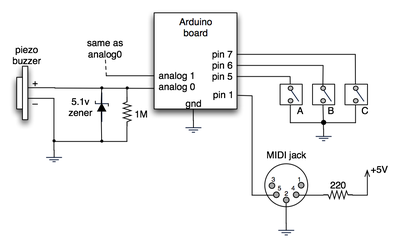
IR Music Transmitter and Reciever

This circuit is designed to generate audio musical notes that can be heard from a distance of up to 10 meters. The circuit consists of two main components: an infrared (IR) music transmitter and an IR music receiver. The IR music transmitter operates on a 9V battery, while the IR music receiver functions with a regulated voltage of 9V to 12V. The first diagram illustrates the circuit of the IR music transmitter, which utilizes the popular melody generator integrated circuit (IC) UM66 (IC1) to continuously produce musical tones. The output from IC1 is connected to an IR driver stage, constructed with transistors T1 and T2, to enhance the transmission range. A red LED (LED1) flickers in accordance with the musical tones generated by the UM66 IC, indicating modulation. The circuit includes two infrared transmitting LEDs (LED2 and LED3), which must be directed towards the IR phototransistor L14F1 (T3) for optimal sound transmission. The IR music receiver employs the well-known operational amplifier IC A741 and audio-frequency amplifier IC LM386, along with the phototransistor L14F1 and several discrete components, as shown in the second diagram. The melody generated by IC UM66 is transmitted via the IR LEDs, received by the phototransistor T3, and sent to pin 2 of IC A741 (IC2). The gain of this operational amplifier can be adjusted using the variable resistor VR1. The output from IC A741 is connected to IC LM386 (IC3) through capacitor C5 and variable resistor VR2. The melody produced is output through the receiver's loudspeaker (LS1), which is rated at 8 ohms and 1 watt. The volume of the loudspeaker can be controlled using VR2. Disconnecting the power supply halts the melody generation.
The IR music transmitter circuit is centered around the UM66 melody generator, which is capable of producing a variety of musical tones. The output of this IC provides a signal that is amplified and modulated by the subsequent driver stage formed by transistors T1 and T2, ensuring that the transmission is strong enough to reach the intended distance. The flickering of LED1 serves as a visual indicator of the modulation corresponding to the audio output, providing a useful debugging feature during the circuit's operation.
In the receiver section, the A741 operational amplifier plays a critical role in amplifying the weak signal received by phototransistor T3. This amplification is necessary due to the inherent losses that occur during infrared signal transmission. The gain adjustment via VR1 allows for fine-tuning based on the distance and environmental factors affecting the IR signal. Following the A741, the LM386 audio amplifier further boosts the signal to a level suitable for driving the loudspeaker, ensuring that the musical notes generated can be heard clearly.
The use of variable resistors (potentiometers) VR1 and VR2 provides flexibility in adjusting both the gain of the amplifier and the volume of the output sound, respectively. This design allows for user-friendly operation and adaptability to various listening environments. The overall architecture of this circuit not only demonstrates the principles of infrared communication but also highlights the integration of audio generation and amplification in a compact form factor, making it a practical project for audio enthusiasts and electronics hobbyists.Using this circuit, audio musical notes can be generated and heard up to a distance of 10 metres. The circuit can be divided into two parts: IR music transmitter and receiver. The IR music transmitter works off a 9V battery, while the IR music receiver works off regulated 9V to 12V. First diagram shows the circuit of the IR music transmitter. It u ses popular melody generator IC UM66 (IC1) that can continuously generate musical tones. The output of IC1 is fed to the IR driver stage (built across the transistors T1 and T2) to get the maximum range. Here the red LED (LED1) flickers according to the musical tones generated by UM66 IC, indicating modulation.
IR LED2 and LED3 are infrared transmitting LEDs. For maximum sound transmission these should be oriented towards IR photo-transistor L14F1 (T3). The IR music receiver uses popular op-amp IC A741 and audio-frequency amplifier IC LM386 along with photo-transistor L14F1 and some discrete components (second diagram). The melody generated by IC UM66 is transmitted through IR LEDs, received by phototransistor ceived by phototransistor T3 and fed to pin 2 of IC A741 (IC2).
Its gain can be varied using potmeter VR1. The output of IC A741 is fed to IC LM386 (IC3) via capacitor C5 and potmeter VR2. The melody produced is heard through the receiver`s loudspeaker. Potmeter VR2 is used to control the volume of loudspeaker LS1 (8-ohm, 1W). Switching off the power supply stops melody generation. We aim to transmit more information by carrying articles. Please send us an E-mail to wanghuali@hqew. net within 15 days if we are involved in the problems of article content, copyright or other problems. We will delete it soon. 🔗 External reference
The IR music transmitter circuit is centered around the UM66 melody generator, which is capable of producing a variety of musical tones. The output of this IC provides a signal that is amplified and modulated by the subsequent driver stage formed by transistors T1 and T2, ensuring that the transmission is strong enough to reach the intended distance. The flickering of LED1 serves as a visual indicator of the modulation corresponding to the audio output, providing a useful debugging feature during the circuit's operation.
In the receiver section, the A741 operational amplifier plays a critical role in amplifying the weak signal received by phototransistor T3. This amplification is necessary due to the inherent losses that occur during infrared signal transmission. The gain adjustment via VR1 allows for fine-tuning based on the distance and environmental factors affecting the IR signal. Following the A741, the LM386 audio amplifier further boosts the signal to a level suitable for driving the loudspeaker, ensuring that the musical notes generated can be heard clearly.
The use of variable resistors (potentiometers) VR1 and VR2 provides flexibility in adjusting both the gain of the amplifier and the volume of the output sound, respectively. This design allows for user-friendly operation and adaptability to various listening environments. The overall architecture of this circuit not only demonstrates the principles of infrared communication but also highlights the integration of audio generation and amplification in a compact form factor, making it a practical project for audio enthusiasts and electronics hobbyists.Using this circuit, audio musical notes can be generated and heard up to a distance of 10 metres. The circuit can be divided into two parts: IR music transmitter and receiver. The IR music transmitter works off a 9V battery, while the IR music receiver works off regulated 9V to 12V. First diagram shows the circuit of the IR music transmitter. It u ses popular melody generator IC UM66 (IC1) that can continuously generate musical tones. The output of IC1 is fed to the IR driver stage (built across the transistors T1 and T2) to get the maximum range. Here the red LED (LED1) flickers according to the musical tones generated by UM66 IC, indicating modulation.
IR LED2 and LED3 are infrared transmitting LEDs. For maximum sound transmission these should be oriented towards IR photo-transistor L14F1 (T3). The IR music receiver uses popular op-amp IC A741 and audio-frequency amplifier IC LM386 along with photo-transistor L14F1 and some discrete components (second diagram). The melody generated by IC UM66 is transmitted through IR LEDs, received by phototransistor ceived by phototransistor T3 and fed to pin 2 of IC A741 (IC2).
Its gain can be varied using potmeter VR1. The output of IC A741 is fed to IC LM386 (IC3) via capacitor C5 and potmeter VR2. The melody produced is heard through the receiver`s loudspeaker. Potmeter VR2 is used to control the volume of loudspeaker LS1 (8-ohm, 1W). Switching off the power supply stops melody generation. We aim to transmit more information by carrying articles. Please send us an E-mail to wanghuali@hqew. net within 15 days if we are involved in the problems of article content, copyright or other problems. We will delete it soon. 🔗 External reference





